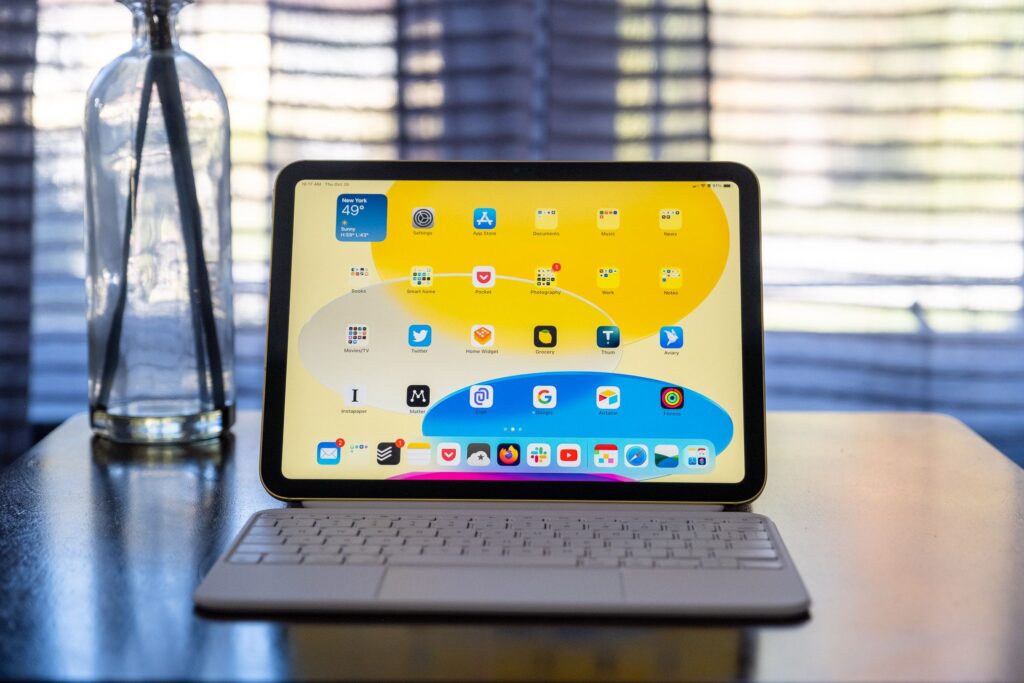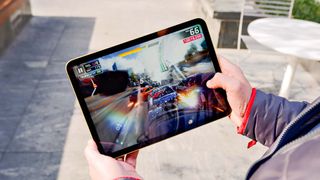Best Apple iPad (10th gen) 2024 review

Table of Contents
The 10th generation iPad ($449) propels Apple’s entry-level tablet into modern times. It sheds the outdated design features, such as the sizable bezels, the old Home button, and the Lightning port.
In their place, you’ll find a nearly edge-to-edge 10.9-inch display, a power button integrated with Touch ID, and USB-C charging.
These updates are just a few highlights of the newest iPad. It now boasts a slimmer and lighter design with flat edges reminiscent of the iPad Air and iPad Pro.
Powered by the speedy A14 Bionic chip, it also offers the convenience of an optional Magic Keyboard Folio with a trackpad for comfortable use.
The vibrant color choices are an added bonus. Altogether, these enhancements make it one of the top tablets available.
What are the drawbacks? Firstly, the $449 starting price is notably higher than its predecessor. Additionally, Apple continues to use the 1st generation Apple Pencil, which still has a Lightning port—though using the Apple Pencil with USB-C can solve this problem.
While the new front camera’s landscape position is a welcome change, the rear camera remains unimpressive. Overall, the $449 starting price feels a bit steep.

In my review of the 10th generation iPad, I will detail all the advantages and disadvantages to help you determine if this is the right iPad for your needs.


The iPad (10th gen) is priced starting at $449/£499/AU$749, which is $120 more than the previous iPad 10.2-inch model. For those wanting 5G cellular connectivity, prices begin at $599/£679/AU$999.
Despite the higher price, the base model still offers only 64GB of storage. If you need more space, you can upgrade to 256GB for an additional $150 on either model.
The iPad 10.2 (2021) is still available from Apple at a lower starting price of $329/£369/AU$549. For a detailed comparison of these two models, refer to our iPad 2022 vs. iPad 2021 guide.
To find the latest discounts, visit our best iPad deals page.

IPAD 10TH GEN REVIEW: SPECS
iPad 10.9-inch (2024)
| Starting price | $449/£499/AU$749 |
| Display | 10.9-inch (2360 x 1640) Liquid Retina |
| OS | iPadOS 16 (pre-installed) |
| Chipset | A14 Bionic |
| Storage | 64GB, 256GB |
| Rear camera | 12MP |
| Front camera | 12MP with 122-degree FOV |
| Video quality | Up to 4K |
| Wireless | Wi-Fi 6, optional 5G |

“Finally!” was my first thought when I picked up the 10th generation iPad. Apple has increased the display size from 10.2 inches to 10.9 inches, eliminating the old Home button in the process.
The result is a nearly edge-to-edge screen, though the bezels are still quite noticeable. A notable improvement is the integration of Touch ID into the Power button, allowing you to unlock the iPad with a simple touch.
To make unlocking convenient in both portrait and landscape modes, I registered my index fingers from both hands. Touch ID worked flawlessly every time.

The new iPad 2022 measures 9.79 x 7.07 x 0.28 inches and weighs 1.05 pounds (1.06 pounds for the cellular model), making it thinner and lighter than the 9th generation iPad, which measures 9.8 x 6.8 x 0.29 inches and weighs 1.07 pounds (1.09 pounds for cellular).
Apple has introduced vibrant new colors for the iPad 2022. I tested the bold yellow model, a striking blend of yellow and gold. Other options include pink, blue, and silver, with blue being my personal favorite.
While the iPad 2022 is visually appealing, it’s important to note that it may not be very durable based on recent tests.

The 10.9-inch display on the iPad 2022 might not be extraordinary, but it offers solid quality for its price. While watching the trailer for Wakanda Forever, I appreciated the vivid colors, especially in the scene where Namor emerges from the water, his gold and navy blue armor gleaming around his neck.
Browsing through pictures in the Photos app was also a pleasant experience. I was able to discern tiny water droplets on a flower as I zoomed in on a photo taken with the new 10th generation iPad.

In our lab tests, the iPad 2022 reached a maximum brightness of 504 nits, closely aligning with Apple’s 500-nit claim. While this is decent, you might struggle to see the screen clearly in direct sunlight, as I experienced.
For comparison, the iPad Pro 2021 achieved a maximum brightness of 1,588 nits, though it’s a significantly pricier device. Even the iPad Pro 2022, despite not performing as well in our tests, still reached 1,577 nits.
When it comes to color reproduction, the iPad’s display covered 101.2% of the sRGB color gamut and 71.7% of the more stringent DCI-P3 color space. In comparison, the iPad Air’s panel reached higher percentages at 111.8% and 79.2%, respectively.
However, it’s worth noting that the colors on the iPad 10th gen were slightly more accurate according to the Delta-E test, where lower numbers indicate better accuracy. The new iPad scored 0.21 compared to the Air’s 0.29 and the Pro’s 0.3.

The Magic Keyboard Folio for the iPad serves as an excellent accessory if you’re aiming to transform your tablet into a compact laptop. Though priced at $249, the keys provide a satisfying 1mm of travel and responsive feedback.
I was pleasantly surprised by my performance when I conducted a typing speed test on 10fastfingers.com. I achieved an average speed of 71 words per minute with 96% accuracy, matching my pace on the 14-inch MacBook Pro. However, some keys are smaller due to the overall size of the tablet, notably the Return and Delete keys.
Additionally, the keyboard boasts a 14-key function row at the top, allowing easy access to all open apps and convenient adjustments to brightness and volume.

The Magic Keyboard Folio features an adjustable kickstand that’s simple to set up, providing stability for typing, even when the iPad 2022 is on your lap, though there’s a bit of bouncing.
While I appreciate the magnetic attachment of the protective back panel to the iPad, it occasionally slipped off, indicating it could be more secure.
If you prefer, you can detach the keyboard and utilize the back panel as a stand for activities like watching movies.

Apple Pencil support is my primary frustration with the new iPad. It’s perplexing for a company renowned for its intelligent design choices.
Unfortunately, the iPad 10th gen doesn’t accommodate the latest 2nd gen Apple Pencil. If you want to utilize drawing, note-taking, and other features with this iPad, you’ll need to invest in the $99 1st gen Apple Pencil.
There are a couple of significant drawbacks here. Firstly, there’s no designated storage space for the Apple Pencil when it’s not in use.
Unlike the iPad Air and iPad Pro, which allow you to magnetically attach the 2nd gen Apple Pencil to the top flat edge for convenient storage and charging, the iPad 10th gen lacks this feature. Additionally, the removable cap on the 1st gen Apple Pencil is prone to being misplaced.

The Apple Pencil compatibility with the iPad 2022 presents additional challenges. To pair and charge the 1st gen Apple Pencil, you must use a separate USC-C to Apple Pencil adapter, as the Pencil still relies on the old Lightning connector instead of USB-C. Although Apple includes this adapter with the purchase of the 1st gen Apple Pencil, it’s unfortunate that such a cumbersome solution is necessary.
It would have been far more convenient if Apple had opted to include support for the Apple Pencil 2nd gen with the iPad 2022.
Nevertheless, the Apple Pencil performs admirably. A colleague used it to effortlessly create an intricate flower illustration, and I appreciate its ability to transcribe handwritten notes into text in any text field. Many third-party apps, such as Pixelmator, GoodNotes, and ProCreate, leverage the capabilities of the Apple Pencil. Particularly impressive is ProCreate’s responsiveness to pressure sensitivity from the Pencil, allowing for nuanced line work.
Thankfully, the new $79 Apple Pencil features USB-C charging and can magnetically attach to the iPad. While it doesn’t charge while attached, the convenience of this storage option is welcomed. However, it lacks pressure sensitivity. For those purchasing the iPad without an existing Apple Pencil, this more affordable option is preferable to the Apple Pencil 1.

As expected, the A14 Bionic chip powering the iPad 2022 delivers impressive performance, which is unsurprising considering it’s the same processor found in the iPhone 12.
When playing demanding games like Genshin Impact, I experienced smooth animations, and the iPad performed admirably even when facing multiple enemies simultaneously. The only minor slowdown occurred while navigating rocky terrain.
According to Geekbench 5, a benchmarking tool for overall performance, the iPad 2022 achieved scores of 1,580 for single-core and 4,400 for multi-core performance, representing a significant improvement over the 9th generation iPad’s scores of 1,384 and 3,387, respectively.
However, the iPad Air, equipped with the M1 chip, achieved notably higher scores of 1,707 for single-core and 7,151 for multi-core performance.
In terms of graphics performance, the iPad 2022 achieved a score of 8,579 and 51.4 frames per second on the 3DMark Wild Life test. This represents a slight improvement over the 9th generation iPad, which scored 8,000 and 47.9 fps. As expected, the iPad Air outperformed both, scoring 17,966 and 107 fps.

Interestingly, in our video transcoding test using Adobe Premiere Rush, the new iPad completed the task slightly slower than the 9th generation iPad, taking 29 seconds compared to 27 seconds, although both times are commendable. Meanwhile, the iPad Air completed the task in just 22 seconds.
Our review unit was equipped with a 5G cellular connection for Verizon, so we tested its performance using the Ookla Speedtest app.
In central New Jersey, near my home, I observed download speeds of only 38 Mbps and upload speeds of 4.09 Mbps. However, in midtown Manhattan, download speeds exceeded 100 Mbps. The performance of 5G connectivity largely depends on your location and signal strength.
It’s important to note that the new iPad’s USB-C port supports only USB 2.0 data transfer speeds. Tests conducted by various outlets revealed that it maxes out at around 480 Mbps, similar to the speeds offered by Lightning connections.

The iPad 2022 features an upgraded back camera, boasting a sharper 12MP resolution compared to the 8MP camera found in the previous model.
Additionally, the front camera has been enhanced to 12MP and has been repositioned from the top edge to the long edge of the tablet. This adjustment facilitates more natural video calls in landscape mode, particularly when the iPad is docked in the Magic Keyboard Folio.

The performance of the rear 12MP camera on the iPad 2022 varies depending on the environment. When capturing images outdoors, the iPad 2022 delivers vibrant and detailed photos, as demonstrated by a flower shot.
The camera adeptly captures small water droplets on the petals while skillfully blurring the surrounding foliage, resulting in an image worth sharing.
Indoor photography with the iPad 2022 is satisfactory under adequate ambient lighting conditions. However, in a photo of a witch’s boot on a fireplace mantle, I noticed some graininess.
While it may not be entirely fair to compare, the iPhone 14 Pro Max produces brighter photos with significantly less noise in similar conditions.
Unfortunately, the absence of Night mode on the iPad 2022 is disappointing. Furthermore, there is no flash available, although this is also a feature lacking in the iPad Air 5th gen.
On the front, the iPad is equipped with a 12MP camera positioned along the long edge of the display in a new landscape location.
This placement enhances the device’s suitability for video calling. Even in dimly lit environments, the iPad delivers relatively sharp images of faces and hair, albeit with some noise present, particularly in clothing. Additionally, the iPad intelligently illuminates the display, effectively serving as a makeshift flash when needed.

The iPad 2024 is designed to provide ample battery life throughout the day, so you may find yourself able to forgo the included 20W charger. In our Tom’s Guide Battery Test, where continuous web surfing at 150 nits of screen brightness is conducted, the iPad 10th gen impressively lasted 10 hours and 57 minutes over Wi-Fi.
Comparatively, the iPad 2023achieved a longer runtime of 11 hours and 59 minutes. However, as we continue testing, the iPad 2024 may narrow this gap with further runs once we average the results. In contrast, the iPad Air endured for a shorter duration, clocking in at 10 hours and 9 minutes.
The inclusion of USB charging in the iPad 2022 is a welcome feature, as it led to faster recharge times in our testing compared to the previous model.
Within 30 minutes, the new iPad reached 26% charge, whereas the Lightning-equipped iPad 9th gen only reached 19%. Though not a substantial leap, any improvement in charging efficiency is appreciated.

Let’s address the elephant in the room: the new iPad 2022 doesn’t support the flagship feature of iPadOS 16, Stage Manager. This feature streamlines multitasking by placing your recently used app on the left side of the display.
However, there are still several noteworthy features of iPadOS 16 that you can take advantage of. For instance, in Messages, you now have the ability to edit or unsend a message after it’s been sent. Additionally, you can copy, translate, or pin text directly from a video frame.
One of my personal favorite features of iPadOS 16, which I tested on the new iPad, is the ability to separate a subject from the background in an image (similar to iOS 16). By pressing and holding on the subject within a photo, you can effortlessly drag and drop it elsewhere, such as into an ongoing message.
iPadOS 16 also brings various refinements tailored for the larger iPad display. These include customizable toolbars, the capability to view folder sizes in Files, and a more consistent Undo and redo experience, as well as the addition of find-and-replace functionality in apps.
For my personal needs, I’d lean towards the iPad 10th gen since I don’t find myself relying heavily on the Apple Pencil. However, if you anticipate frequent use of the Pencil for tasks like drawing or note-taking, I’d recommend investing in the pricier $599 iPad Air. It supports the newer 2nd gen Apple Pencil, which conveniently attaches to the tablet for storage and charging.
Furthermore, the iPad Air boasts a faster M1 chip and offers support for the new Stage Manager multitasking feature. However, it’s important to note that accessories for the Air come at a higher price point. The Apple Pencil costs $129, and the Magic Keyboard is priced at $299, compared to $99 and $249, respectively, for the equivalent add-ons for the new iPad 2022.
For a more in-depth comparison between Apple’s two tablets, check out our iPad 2022 vs. iPad Air 2022 face-off.

The iPad (10th gen) presents a refreshed look and feel, marking a welcome departure from its recent predecessors.
The sleeker design and expanded display are notable improvements, although some users may lament the absence of the headphone jack present in the 9th gen iPad. Nevertheless, the inclusion of features like the Touch ID-enabled power button, relocated front camera, USB-C charging, upgraded A14 Bionic chip, and 5G connectivity add to its appeal.
However, the $449 price tag may give some potential buyers pause. While the $329 iPad 9th gen remains an option, the $120 increase from one generation to the next can be hard to swallow.
Additionally, the Apple Pencil presents a cumbersome charging and storage dilemma, although the $79 Apple Pencil offers a solution to this issue.
Is the iPad 2022 worth the investment over its predecessor? For the most part, yes, as it represents a more future-proof tablet.
Overall, the iPad 10th gen stands out as one of the top tablets available. However, the higher price and Apple Pencil inconvenience may make it less appealing to some users, preventing me from unequivocally declaring it the best tablet for most people.
Pros
- +Sleeker design with slimmer bezels
- +Fast A14 Bionic processor
- +Long battery life
- +Comfy Magic Keyboard with touchpad
- +Cellular upgraded to 5G
Cons
- –More expensive than previous model
- –Apple Pencil awkward to charge
- –Just 64GB of storage
- –Doesn’t support Stage Manager in iPadOS 16
price : $326.22

